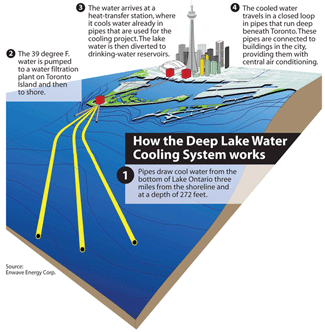L'ÉNERGIE DES VAGUES ET DES COURANTS MARINS
Actualité internationale
2007
Canada: Toronto turns to lake water for air conditioning
http://www.csmonitor.com/2007/0830/p13s01-stgn.html

| The Toronto Dominion Centre is
the most distinctive set of office towers in the city's financial district.
Three of the five black buildings were designed by Mies van der Rohe and
built in the late 1960s. So was their air conditioning.
The three original towers, which contain about 3 million square feet of office space, were among the first buildings connected to Toronto's Deep Lake Water Cooling System in September 2004, saving the local electric utility 7.5 megawatts of electrical demand every working day. "This conservation measure takes the pressure off Toronto's electrical system," says Blair Peberdy, vice president of Toronto Hydro, the local utility. The city's electricity supply tightens during the hot summer months, he says, so "removing air conditioning from the grid helps the system." The first stage of the project's construction ran three 63-inch diameter pipes along the city's lake bed about three miles out into Lake Ontario. There it draws water 272 feet below the surface. At that depth, the water's temperature is almost always constant, protected by a strata of water above it called a thermocline. "Below the thermocline, the water stays at 39 degrees Fahrenheit almost the entire year. That's the natural phenomenon that is our renewable resource," says Kevin Loughborough, vice president, major projects, at Enwave Energy Corp., which owns and runs the Deep Lake Water Cooling project. The water is piped to a filtration plant on Toronto Island, less than a mile off the city's shoreline. It then continues to a heat-transfer station on the mainland squeezed between the Rogers Centre and the downtown Gardner Expressway. Here the lake water runs along one side of a metal plate in a heat exchanger, transferring the water's "coolness" to water running through pipes on the other side of the plate. The lake water is sent along to reservoirs, providing about 15 percent of the city's drinking water. Since the water comes from so far out in the lake, it is free from such contaminants as algae and geosmin, which cause an unpleasant taste and odor in Toronto's water in the late summer and early fall. The water used to cool the city's buildings travels in a closed loop inside 48-inch pipes that run for 15 miles beneath the city, six stories deep. The cool water passes though metal coils inside participating office buildings. Fans blow over the coils, forcing cool air into each building's central air-conditioning system. Toronto's system is connected to 41 buildings in the central business district, and a total of 57 buildings have signed on to use the system. Built at a cost of $200 million over four years, the system has two shareholders: the City of Toronto (47 percent ownership) and OMERS, the Ontario Municipal Employees Retirement System (53 percent). Significant energy savings during peak periods
|
The two newer TD towers, modeled after van
der Rohe's designs, were connected to the system last fall. For the first
time this past summer, the entire TD Centre was air-conditioned by the
water pulled in from Lake Ontario, saving a total of 10 megawatts of electricity
during peak periods. Another 12 megawatts are similarly saved from connections
to the Royal Bank Plaza and the Metro Centre, home to the local city government.
All those buildings are close to Lake Ontario.
Perhaps the most ambitious connection is Queen's Park, seat of the provincial government, located about two miles from the lake. The legislature and some nearby government office buildings were connected in April, saving four megawatts of electricity. New buildings that join the Deep Lake Water Cooling System should never have to build cooling units. Among them is a 25-story condominium complex built by Tridel, a local developer, in downtown Toronto. It was hooked into the project from the start. The system has other benefits besides saving energy. Most office and apartment towers have cooling units on their roofs. Removing them means the roof can be used for something else, perhaps a running track. The three original van der Rohe towers have cooling units built between floors, appearing as black, windowless bands from the outside. The owner is now working out how to convert those areas into office space, which is almost as precious as electricity in downtown Toronto. Still, the largest benefit created by the cooling system has been to reduce the city's demand for electricity during in the peak summer season. The two transformer stations at each end of Toronto's financial district has been hard-pressed to keep up with demand from computers, lighting, and air conditioning. "Toronto Hydro gives Enwave a check every time we sign a new building on their grid," says Enwave's Mr. Loughborough. "We call it 'nega-watts,' where instead of creating new generating capacity, you lower the demand for power." Other cities could benefit from similar systems:
Other cities that might benefit for using cold offshore water:
|